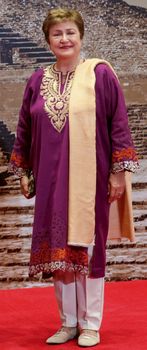Now that the G20 Summit is done and dusted, host city Delhi can get back to its quotidian routine. Morning walks at the Lodhi gardens, lunch at the Chinese restaurant at Claridge’s, followed by an afternoon trawl at Khan Market and late-night negronis at an MP’s Lutyens bungalow. Never mind that the minutiae and the MOUs of the summit are barely known—most of it is related to Russia-Ukraine and climate change anyway. The most important task of a geopolitical junket is to create amazing photo ops.
Perhaps this is also why we are so obsessed with who wore what at the G20. After all, with the world’s most powerful leaders congregating in India for the first time, Indian clothing customs were the biggest winners.
I’m just going to get Rishi Sunak and his wife Akshata Murty out of the way first as both were predictably dull. Sunak’s ankle-length trousers may have been a thing in the UK, but in India, we usually wear our trousers short, thanks to the diktat of dusty roads, humid days and pricey gabardines. All eyes were on Murty as she stepped out in a crisp white shirt and a floral printed lehenga skirt (of yet unknown provenance), but she ended up boring us with the rest of her suitcase of Indian or Indian-origin designers. A printed dress and another lavender one from British Indian designers Saloni and Manimekala respectively. I am glad that she wore Fabindia. I am not a fan of the apparel at this chain of stores, but it is a promoter of local crafts and one of India’s first startups. Her finale sari—a pink organza Raw Mango—was the final fashion nod we snobs were waiting for.
The rest of the dignitaries gave respect to Indian clothing with their delightful experiments. The Italian prime minister Giorgia Meloni had multiple memes to her credit—it is probably the unfortunate price women politicians pay for being attractive. She wore an elegant Indian shawl with her gorgeously tailored black dress. The IMF director Kristalina Georgieva chose a purple Kashmiri style kurta or a pheran with a dupatta and wore them quite chicly with white trousers and sneakers, while her deputy Gita Gopinath wore a blue silk sari. The World Bank’s Ajay Banga wore his turban with trademark elegant suits, while his wife wore a mint green Raw Mango sari.
The Japanese prime minister’s wife Yuko Kishida showed up in a green and pink zari and silk weave, with a classic bindi on her forehead. And who could miss the gajra (hand-strung Indian jasmines) that the South African president’s wife Tshepo Motsepe wore in her hair. Kobita Jugnauth, the wife of the Mauritian PM, wore an elegant white chikankari with a contrasting full-sleeve blouse.
But the finest saris expectedly came from Bangladesh PM, Sheikh Hasina. She wore a fusion of two types of jamdani saris on one day, jamdani being a gossamer-thin muslin that originated in her country and moved westward to Bengal. Hasina wore jamdanis every day of the summit, and easily stole the show. President Droupadi Murmu’s white Benaresi ashrafi was quite a classic too, made contemporary with its contrasting blue minakari border. Mamata Banerjee stayed true to her Dhaniakhali wardrobe, with the undyed white saris she purchases for just a few hundred rupees each from one of the poorest parts of Bengal. The austerity of these saris are now her political capital.
Politicians have long learned that their attire is the most powerful tool of communicating their ideologies. The Instagram generation is only just discovering the importance of a visual language.


